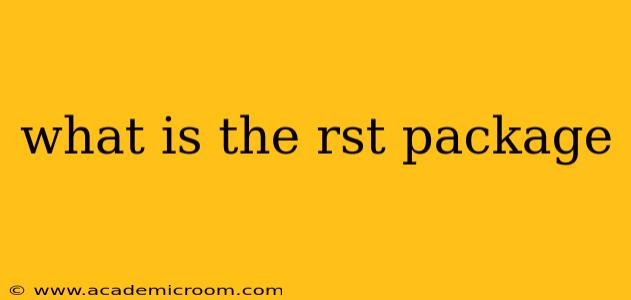The term "RST package" is somewhat ambiguous, as "RST" itself isn't a universally recognized acronym within the context of software packages or programming. It's likely that the abbreviation refers to a specific context or a niche area, and without more information, a precise answer is difficult. However, the most probable interpretation relates to reStructuredText, a markup language often used for documentation. Let's explore this possibility and delve into related questions frequently asked about documentation tools.
What is reStructuredText (reST)?
reStructuredText (often shortened to reST) is a markup language used to structure text. It's particularly popular in the Python community and is often used to write documentation for Python projects. Unlike other markup languages like Markdown, reST is more feature-rich and offers greater control over formatting and document structure. This makes it suitable for creating complex, well-organized documentation. It provides tools for creating:
- Sections and subsections: Easily organize content into logical units.
- Lists: Bullet points, numbered lists, and definition lists.
- Tables: Present data in a structured format.
- Footnotes and citations: Support academic writing styles.
- Links: Internal and external links to other documents or websites.
- Code blocks: Highlight and format code snippets.
Think of it as a more powerful and versatile cousin to Markdown. While Markdown is great for quick and simple text formatting, reST excels in scenarios where more sophisticated document structuring is required.
Is there a specific "RST package" for a particular programming language or environment?
There isn't a single, universally recognized "RST package." The way reStructuredText is handled depends heavily on the context. Often, the support for reST comes built into documentation generators or as part of larger toolchains. For instance, Sphinx is a popular Python documentation generator that uses reST as its input format. Sphinx itself can be considered a "package" in that it's a collection of tools for creating documentation, but it's not specifically called an "RST package". Other tools and frameworks also incorporate support for reST without being named specifically "RST packages".
How do I use reStructuredText?
The use of reST varies depending on the tools you employ. If you're using Sphinx (a common use case), you'll write your documentation in .rst files using reST markup. Sphinx then uses this markup to generate HTML, PDF, or other formats suitable for publishing. Other tools may have their own methods for handling reST.
What are the alternatives to reStructuredText?
Several alternatives exist to reStructuredText for writing documentation:
- Markdown: A simpler, more lightweight markup language. Easier to learn but lacks some of the features of reST.
- AsciiDoc: Another popular markup language, often used in open-source projects.
- DocBook: A more complex XML-based language used for technical documentation.
To provide a more precise answer, please clarify the context in which you encountered the term "RST package." Knowing the specific software, programming language, or environment would help significantly in determining what "RST package" refers to.
